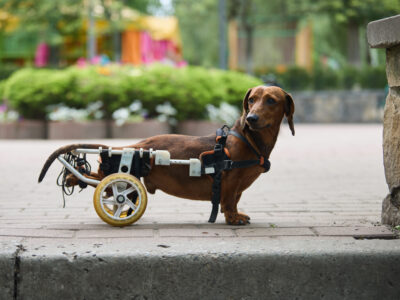
For years the veterinary community has debated about surgery vs crate rest as the best treatment for dogs with IVDD.
Well, exciting research conducted by the Queen’s Veterinary School Hospital at Cambridge University finally has a definitive answer. Their 2024 study found that the conservative approach of crate rest and physical therapy, can be as effective as surgery to get dogs walking again.
Note: Some of the links in this article are affiliate links. As an Amazon Associate, I earn from qualifying purchases.
About Intervertebral Disc Disease (IVDD)
Intervertebral disc disease is a common cause of hind end paralysis in dogs. It’s estimated that 2 percent of canines will be affected during their lifetime.
IVDD causes the discs in the spine to age faster than normal. In some dogs, the jelly-like fluid that serves as a cushion to the spine, dries out and ruptures. In other dogs the jelly softens until it bulges and ruptures the spine.
The conservative approach
When I first started helping pet owners adjust to life with a paralyzed dog, I was introduced to an amazing woman named Linda Stowe. She’s the founder of a website called Dodgerslist and the authority about treating IVDD dogs with a conservative approach that doesn’t use surgery.
Linda started her organization after reading about Dodger, a Dachshund who suffered a ruptured disc due to IVDD. Dodger was in tremendous pain so his owners brought him to their veterinarian, where he was immediately euthanized.
Unfortunately, this was the standard protocol for IVDD dogs in 2002, unless you were lucky enough to have a vet who would do spinal surgery.
Dodger’s story deeply touched Linda, and she set out to learn as much as she could about IVDD. Her research led to the conservative approach to healing dogs. It changed the lives of dogs worldwide.
It consists of:
- Strict crate rest for at least 6-8 weeks to allow a dog’s spine to heal. Dogs stay in a comfortable size X-pen or dog crate where they can stand, turn around, play with toys, but are protected from injuring themselves.
- Medications are administered during crate rest to reduce inflammation and relieve pain.
- Light exercise and bathroom breaks are also administered, but for the most part dogs eat, sleep and play in the crate.
- A regime of physical therapy that’s prescribed by your dog’s veterinarian is also started during this time.
The Cambridge IVDD conservative treatment trial
The study focused on whether conservative treatments, like crate rest and physical therapy, could be an effective therapy instead of surgery for IVDD dogs.
The goal was to determine how many paralyzed dogs with “acute thoracolumbar disc extrusion” (a ruptured disc where the upper and lower part of the spine meet) would regain their mobility during 12 weeks of conservative recovery. This meant 24-hour crate rest and daily PT as their treatment.
A total of 72 owned dogs that were enrolled into the trial. MRI scans were taken on day one and after 12 weeks. Dogs who could take 10 consecutive steps without falling after 12 weeks of crate rest were considered to be recovered.
In addition, dogs were hospitalized for 2 days at the start of the study to receive pain medication. Once they were home each dog was allowed out of their crate 4-5 times a day for bathroom breaks. After 4 weeks, if the dog started to walk, daily walks of 10 minutes were scheduled 4 times a day.

The results
49 of the dogs (96%) who had feeling in their paws after their disc ruptured, but before crate rest, were able to walk again.
10 of the dogs (48%) who lost sensations in their paws after their disc ruptured, also regained their ability to walk a minimum of 10 steps.
The average time for each group to take their first steps was 11-25 days.
The severity or “compression” to the spinal cord of each dog “appeared to be unrelated to their recovery.”
During recovery 2 of the dogs passed away and 2 other dogs became paralyzed again. Nearly all of the dogs in the trial were standard or miniature dachshunds.
What this means for the future
While surgery remains the best choice for dogs with severe cases of IVDD, the Cambridge trial shows that the conservative approach is effective for many IVDD dogs.
It provides the opportunity for them to recover and walk again, without having to undergo surgery. In addition, conservative treatment is inexpensive. It offers a solution to pet families who can’t afford the cost of spinal surgery and hospitalization for their pet.
I’m sure this is a therapy we will be hearing about more in the near future.

Get the Essential Guide
The Essential Guide of Products for Handicapped Dogs e-book is a labor of love for me. I wrote it to answer your most pressing questions about where to find the best products for your wheelchair dog. You’ll find products you didn’t know existed and each will improve your dog’s quality of life. Print a copy and keep it by your side.
Resources about IVDD
Written by two veterinarians, Honey, Have You Squeezed the Dachshund is one of my favorite books for families with a recently diagnosed dog.





Leave a Reply